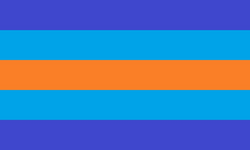Multigender: Difference between revisions
No edit summary |
No edit summary |
||
| Line 1: | Line 1: | ||
{{poorly-attested identity}} | {{poorly-attested identity}} | ||
{{infobox identity | {{infobox identity | ||
| name = Multigender | | name = Multigender | ||
Revision as of 18:38, 25 July 2018
| |
This page is about a gender identity that is not widely used among gender-variant people. This does not mean that the identity is not valid, but that very few people are known to use this term. More information on uncommon identities... |
 | |
| Related identities | bigender, trigender, pangender, polygender |
|---|---|
Multigender is an umbrella term, but may also be used as a specific gender identity. Multigender identities all fall under the nonbinary and transgender umbrellas. The multigender umbrella includes bigender, trigender, polygender, pangender, genderfluid, and possibly androgyne. Multigender individuals have more than one gender identity, either at the same time, or moving between different gender identities at different times. They may or may not seek a physical transition to change their body.[1]
List of specific kinds of multigender identities
Transgender people have created many words for specific kinds of multigender identities. These are some of the most used multigender identities:
- ambigender: experiencing two genders simultaneously and without fluidity or shifting.[2] This word has also been defined as like being ambidextrous, only with gender. It has also been defined as a synonym for bigender (see below).
- bigender is an identity with two gender identities. This word can mean both genders at the same time, or moving between two genders. In the latter case, bigender is a specific kind of genderfluid identity.
- demiflux: used by polygender or bigender people to describe when one of their genders is static and the other change in intensity and presence.[3]
- genderfluid is a gender identity that changes from one time to the next. For example, a genderfluid person could be both a boy and a girl one day, and then genderless the next.[4]
- pangender is an identity with a wide multiplicity of genders that can tend to the infinite (only includes genders of one's culture. This applies to all other nonbinary genders, because one cannot identify with gender(s) outside their culture).[5]
- polygender is an identity with several gender identities, particularly four or more of them. This can mean at different times, or at the same time.[6]
- trigender is an identity with three gender identities. This word can mean all three at once, or moving between three genders.[7]
See also
References
- ↑ Jenny Crofton. «What It Means To Be MultiGender: The Questions Many Have, But Are Afraid To Ask». The body is not an apology. 7 December 2016
- ↑ https://en.wiktionary.org/wiki/ambigender
- ↑ http://www.thecsph.org/id-a-day-a-demigender/
- ↑ https://www.theguardian.com/commentisfree/2016/mar/23/gender-fluid-generation-young-people-male-female-trans
- ↑ http://www.dictionary.com/browse/pangender
- ↑ https://en.wiktionary.org/wiki/polygender
- ↑ https://en.wiktionary.org/wiki/trigender
